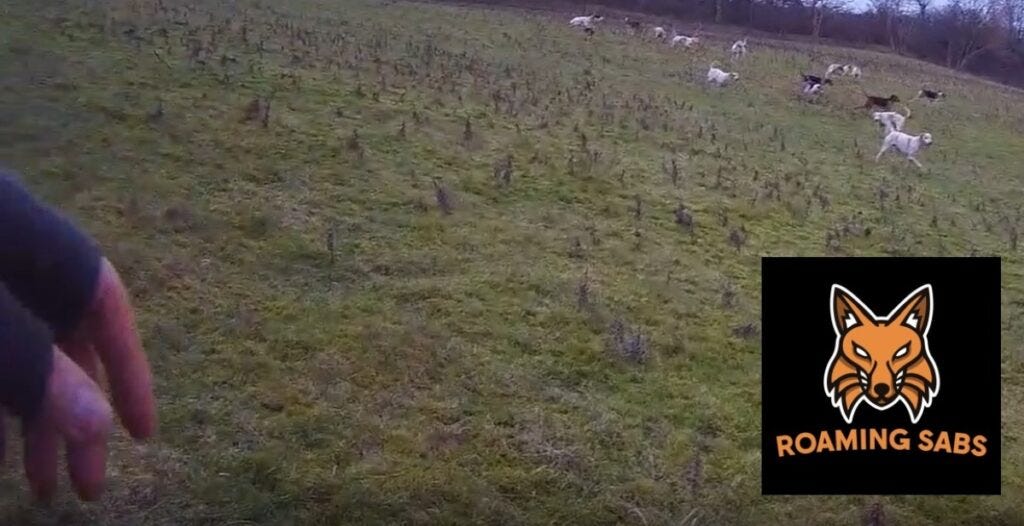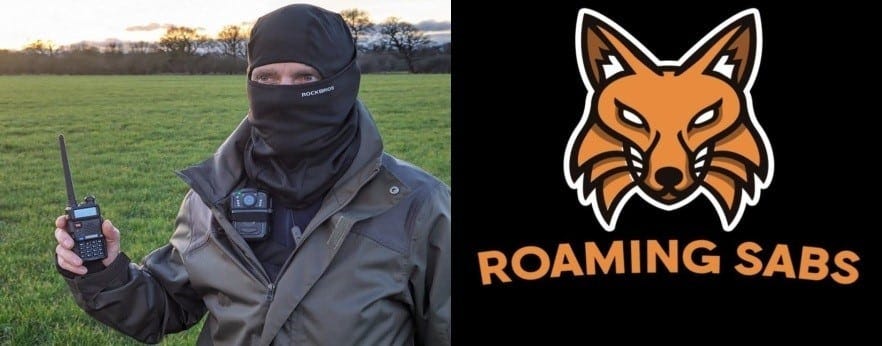What is ‘rating’ hunting hounds and why do it?
The Roaming Sabs provide the answer (video is NOT graphic and no animal is struck or hurt)
Hunting – and hunt sabbing – is packed with jargon and arcane terminology that can be very confusing at first glance. Written reports often feature terms like ‘casting’, ‘cap fees’, and ‘marking’. They might say that the hounds were ‘speaking’ or were perhaps ‘rioting’. All have very specific meanings. Another term that is often found in sab and monitor reports is ‘rating’.
Rating hounds is ‘telling them off’. Hunting hounds are trained to respond in a certain way, and sabs have become experts at using that training to ‘distract’ the hounds and get them to stop chasing. It sounds pretty straightforward, but ‘rating’ successfully is more difficult than you might think. When it’s done well, though, it is a thing of beauty…
Last week our friends the Roaming Sabs, an independent group based around Manchester, sent us a short video of one of their members ‘rating’ hounds from the Middleton Hunt. It’s not graphic in any way, and no animals are hurt. As a visual explanation of ‘rating’ it’s pretty much perfect. Enjoy!
On 1 February, the Roaming Sabs publicly shared a video showing one of their members using their voice and a whip to turn the Middleton Hunt’s pack of hounds around. The Sabs said the hounds were “on… the line of a fox” at the time but that the sab’s actions helped the fox escape. Specifically, the group said these actions had “rated” the hounds. But what is rating and why do it?
Rating the hounds can be thought of as a form of reprimand. It is a way of telling the hounds that they are doing something wrong and must stop. And in the Roaming Sabs’ video this is done through a combination of voice commands and ‘whipping’ the hounds (which is not what it sounds and no hound is struck or hurt).
‘Rating Hounds’ by the Roaming Sabs. Video is not graphic, the hounds are not struck or hurt.
“Leave it! Back to him!”
The most notable element of the video is the sab’s shouting. Their voice is heard throughout the video saying two commands: “Leave it” and “Hack to him” or “Back to him”. These are traditional hunting voice commands used by hunt staff (huntsman and whippers-in) to reprimand hounds when they are doing something the huntsman doesn’t want them to. Their meanings are fairly cut and dry, with the “it” of the first command being the quarry and the “him” of the second command referring to the huntsman.
Whilst these terms are broadly used, huntsmen can also train hounds to obey other terms. That’s because the words themselves are only half the message.
As critical theorist Marshall MacLuhan stated, “the medium is the message”, and that is true for hunting voice commands as well. When telling the hounds to “leave it” and “get back to him”, the sab in the video does so in a specific tone of voice. It is rough and gravelly without being shouty. That’s because the huntsman has trained the hounds to understand this tone as one of reprimand – they are doing something they shouldn’t and must stop.
‘Whipping’ the hounds
These voice commands are also accompanied by the cracking of a whip. Because the huntsman has previously trained the hounds to respond to the sound of a cracking whip, it is only the sound that is needed. A sab would never physically whip the hounds (or any animal come to that), of course. Unfortunately, this training will see the huntsman physically whipping the hounds, which is how they learn that it is a form of reprimand. But for sabs in the field, only the sound is needed.
For whipping to be most effective, a sab will want to be directly in front of the hounds. However, in the Roaming Sab’s video, the tactic appears to be effective even though the sab is to the side of the pack. This is likely due to the state that the hounds are in at the time.
As the sab runs towards the pack, the hounds are ‘casting’, or searching for the scent of a fox that they previously lost. This is seen in the shape of the pack: the hounds are spread out in a line, rather than huddled together in a blob. Furthermore, their heads are down on the ground, trying to find the scent with their noses. They are looking for a lost scent but haven’t yet picked it up, meaning they are still relatively relaxed. As a result, they are more receptive to voice commands and whipping sounds, and more reactive to whipping coming from the side.

What if the hounds were chasing a fox?
Rating with voice and whip is possible if hounds are actively pursuing a fox (or have rioted onto another animal such as hare or deer). However, the whip would almost certainly need to be directly in front of the hounds, and it would need to be cracked much harder and more frequently. Furthermore, the voice commands would need to be delivered louder and with more force behind them, akin to angry shouting. The sab would shout “leave it” as they furiously crack the whip.
In such a situation there would ideally be multiple sabs cracking whips and spread out in a line ahead of the pack. However, you would still only have one or two people using voice commands, because too many people shouting would instead have a detrimental effect. Lots of voices shouting becomes a cacophony that instead encourages the hounds to continue their pursuit because the noise contributes to their chaotic baying (or what those in or following the hunt would call ‘hound music’).
Prevention is better than cure
It is much better to prevent a chase before it has begun than to try and stop a chase after it has started. The second half of Roaming Sabs’ video shows the pack of hounds turning around and going back the way they came. This shows the sab had successfully rated the pack away from the line of a fox they had previously pursued and were trying to recover. Sabs need to step in and rate hounds before they find the scent and start going ‘into cry’ because hounds are more responsive (and thus more easily turned away from their quarry) when they are casting.
As Roaming Sabs explained, as the hounds returned to the Middleton Hunt’s (bemused and frustrated) whipper-in, they saw a fox escaping across the road to safety. The fox is, ultimately, the true hunt saboteur. But the sab played a crucial role in helping the fox escape the terror of a prolonged pursuit and potential death.
(As a sidenote, the same sab heard rating the hounds on the video sent us a photo of his pedometer. It shows he ran an extraordinary 16 kms cross-country, in everyday clothes and carrying a radio, to save the lives of foxes that day!)
Our thanks to the Roaming Sabs for permission to post their video. We have been proud to support the Roaming Sabs in the past with equipment (see ‘Radios (and bodycams) for Roaming Sabs‘) but we can’t help them cover the cost of everything of course. If you’d like to show your support, have a look at their newly set up Ko-fi fundraiser with its innovative ‘membership tiers’.






This has got to be one if the hunts most annoying part when a sab can call the hounds off a fox, what utter satisfaction the sabs must get when they can disrupt these cowards persuing their blood lust GO SABS 👍👍👍👍YOU ARE HEROS
Well done again sans. Diligence, intelligence and bravery. About time that were medals all round.